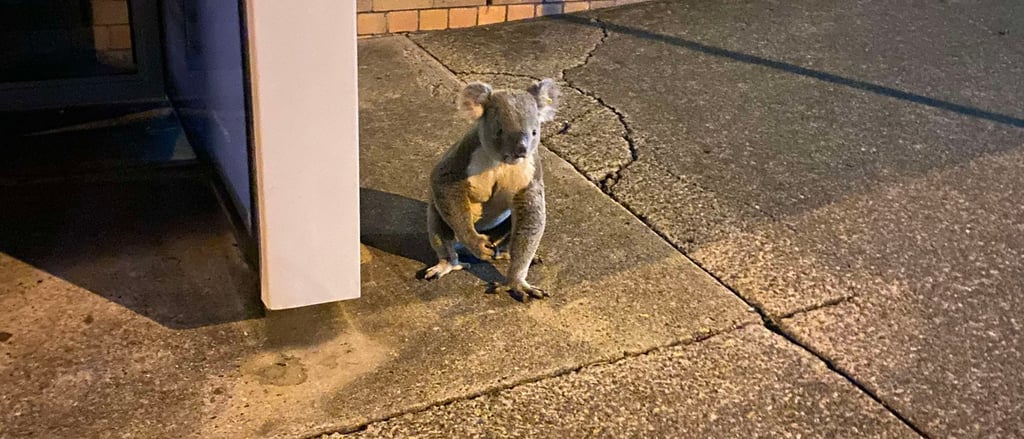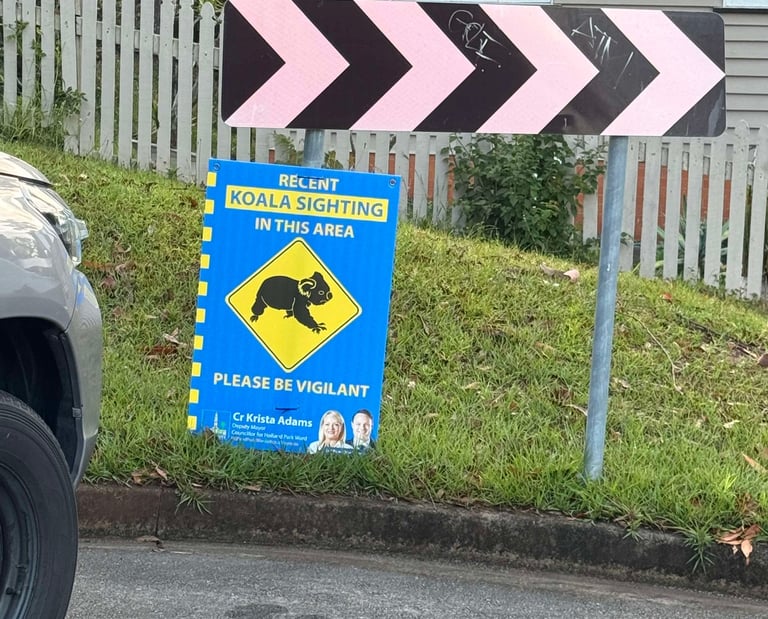Koalas In Danger: Emergency Response Guide
Koala Crossroads
5/8/20244 min read


What to Do If You See a Koala in Danger: Your Emergency Response Guide
Immediate Action: Call 1300 ANIMAL (1300 264 625)
If you encounter a koala in distress, your first and most important action is to call the koala ambulance immediately. In Queensland, call 1300 ANIMAL (1300 264 625) to report sick, injured, orphaned or dead koalas. This 24-hour emergency service connects you with trained wildlife experts who can provide immediate advice and dispatch rescue teams when necessary.
How to Identify a Koala in Danger
Not every koala you see needs human intervention. Koalas naturally spend 18-22 hours per day sleeping and may appear inactive when they're actually healthy. However, certain signs indicate a koala requires immediate help:
Clear Signs of Distress
Immediate Emergency Situations:
Koala hit by a vehicle or showing obvious injuries
Koala sitting at the base of a tree for extended periods (more than 24 hours)
Koala on the ground during daylight hours, especially appearing weak or disoriented
Koala in immediate danger from dogs, cats, or traffic
Koala with visible wounds, bleeding, or limping
Mother koala found deceased - check pouch for surviving joey
Behavioral Warning Signs:
Koala making unusual crying or distress sounds
Koala attempting to climb but unable to do so
Koala showing signs of conjunctivitis (weeping, crusty eyes)
Koala appearing thin or malnourished
Koala exhibiting abnormal behavior like aggression or extreme lethargy
What NOT to Do: Critical Safety Guidelines
Never Approach or Touch a Koala Directly
Koalas have powerful claws and can inflict serious injuries when frightened or in pain. Even injured koalas can be dangerous to untrained handlers. Never interfere with a koala unless it is in clear distress and in need of human assistance.
Do Not Give Food or Water
Well-meaning people often try to feed koalas, but this can be fatal. Koalas have specialized digestive systems designed only for eucalyptus leaves. Water can cause pneumonia if administered incorrectly.
Avoid Loud Noises or Sudden Movements
Stressed koalas can injure themselves further if startled. Maintain a safe distance and speak quietly when calling for help.
Step-by-Step Emergency Response Protocol
Step 1: Ensure Your Safety First
Pull over safely if you're driving
Turn on hazard lights if the koala is near a road
Keep dogs and cats away from the area
Maintain at least 10 meters distance from the koala
Step 2: Call for Professional Help
Queensland: 1300 ANIMAL (1300 264 625)
Alternative: Koala Rescue Queensland - 24-hour rescue service
Provide your exact location (use GPS coordinates if possible)
Describe the koala's condition and immediate surroundings
Follow any specific instructions given by the operator
Step 3: Monitor While Waiting for Help
Observe the koala over a period of time to provide updates to rescuers
Take photos if safe to do so - these help assess the situation
Keep the area clear of people and pets
If the koala moves, note the direction and update rescuers
Step 4: Assist Rescuers When They Arrive
Guide rescue teams to the exact location
Provide any additional information about the koala's behavior
Keep bystanders at a safe distance
Follow any additional instructions from wildlife carers
Special Situations and Considerations
Koala on the Road
Your safety is paramount - never put yourself in danger of traffic
Turn on hazard lights and pull over safely
If the koala is blocking traffic, call emergency services (000) as well as wildlife rescue
Do not attempt to move the koala yourself
Mother Koala with Joey
If you find an injured koala, check the pouch - joeys can survive in the mother's pouch for several days following her death
Report both mother and joey to rescue services
Never attempt to remove a joey from its mother
Koala in Your Backyard
If the koala appears healthy and is just resting, leave it alone
Remove any immediate threats (bring pets indoors)
If the koala remains in the same spot for more than 24 hours, call for assessment
Ensure swimming pools are covered or provide escape routes
Regional Emergency Contacts
Queensland Statewide
Primary: 1300 ANIMAL (1300 264 625)
Koala Rescue Queensland: 24-hour rescue service for sick, injured and orphaned koalas throughout Queensland
South East Queensland Specific
RSPCA Wildlife Hospital: Available through 1300 ANIMAL
Currumbin Wildlife Hospital: Available through 1300 ANIMAL
Australia Zoo Wildlife Hospital: Available through 1300 ANIMAL
New South Wales
Port Macquarie Koala Hospital: Rescue Line: 6584 1522
WIRES: 1300 094 737
Prevention: Creating Koala-Safe Environments
While rescuing koalas in immediate danger is crucial, preventing dangerous situations is equally important:
For Drivers:
Reduce speed in known koala areas, especially at dawn and dusk
Watch for koala crossing signs and take them seriously
If you see a koala near the road, slow down and be prepared to stop
For Property Owners:
Secure dogs and cats, especially at night
Install koala-proof fencing around pools
Plant native trees to provide safe corridor connections
Remove barbed wire fencing that can injure koalas
For Communities:
Report koala sightings using the QWildlife app
Support local koala conservation groups
Advocate for koala-friendly urban planning
When Professional Help Isn't Immediately Available
In remote areas where professional wildlife rescue may be hours away, having contact details of your local carer, vet or wildlife authority prepared in advance gives the animal a better chance of survival. However, never attempt rescue without expert guidance.
If you must wait for professional help:
Create a quiet, safe environment around the koala
Provide shade if the koala is in direct sunlight
Keep detailed records of the koala's condition for rescuers
Take photos to document the situation
The Importance of Reporting
Every koala sighting, whether the animal appears healthy or in distress, contributes valuable data to conservation efforts. Report koala sightings using the QWildlife app to help researchers track population movements and habitat use.
Remember: Successful koala conservation relies on a collaborative approach across all sectors, and for communities to play a role in protecting local koalas. Your quick action and proper response can mean the difference between life and death for these endangered marsupials.
Key Takeaways
Always call 1300 ANIMAL first - they provide expert guidance for every situation
Never approach or touch a koala - even injured koalas can be dangerous
Your safety comes first - never put yourself in danger to help wildlife
Observe and report - detailed information helps rescuers provide better care
Every call matters - professional assessment is always better than guessing
When you encounter a koala in danger, remember that your role is to be the link between the animal and professional help. By following these guidelines, you become part of the solution in protecting Queensland's precious koala populations for future generations.
This guide is based on current wildlife rescue protocols and expert recommendations. Always follow the specific instructions provided by professional wildlife rescue services, as each situation may require different approaches.


